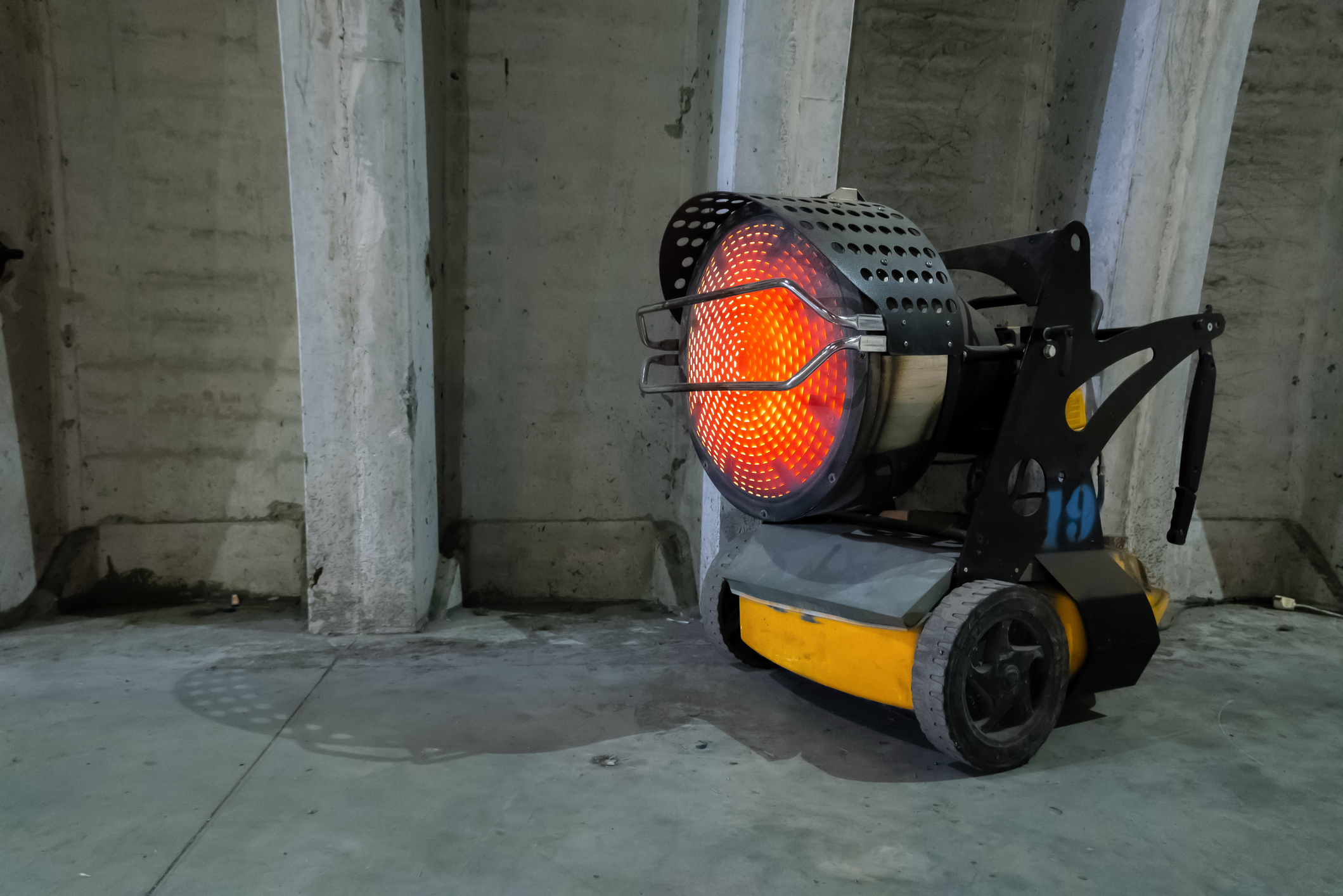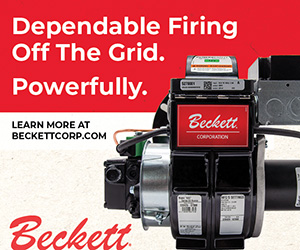
Waste Oil Heaters
by Diane M. Calabrese | Published October 2025

More electric vehicles (EVs) and more efficient internal combustion engines (ICE) add up to less waste from motor oil.
If motor oil is not used, as in the case of EVs, or is used more efficiently, there is less waste oil. The Environmental Protection Agency (EPA) promotes the concept of doing more with less, and in the whole it’s an approach everyone appreciates.
It’s not so much a problem as a fact, though, that if there is less motor oil waste, there’s a smaller stream for fueling waste oil heaters. Thus, the trajectory develops for fewer and fewer heaters in a world where suitable waste oil fuel is rarer and rarer.
But we aren’t there yet, and waste oil heaters are still part of the recycling through reuse landscape, except where they are prohibited.
The giants California and New York City both prohibit waste oil heaters. Many smaller municipalities across the country also do not allow them.
Therefore, the first thing to know about a waste oil heater is whether it can be deployed in a particular place. Maneuvering through the regulations regarding waste oil heaters can be daunting. More will be shared about the rules later.
Let’s start with a concise overview from Delany Johnson, senior manager, sales engineer at Wayne Combustion Systems in Ft. Wayne, IN. Then, we will dig a bit deeper.
“We don’t make waste oil burners,” says Johnson. “Some people use our burner housings and some of our burner components.”
The efficiency of on-site recycling—heat from waste oil—remains an exciting prospect. “But the biggest issue now is that there are lots of synthetic oils that don’t burn like conventional oil,” explains Johnson.
“So, if you were an oil change place, it used to be great to have a waste oil burner to heat the shop with ‘free fuel,’ as they would say,” says Johnson. “At one time it made a lot of sense for an oil shop to have a waste oil heater.” Of course, the fuel is only free if it’s available.
“The problem now is there are so many kinds of oils. Most all new cars take synthetic oil, and it lasts longer in cars,” explains Johnson. “That’s why now most cars are 5,000 to 10,000 miles between oil changes when with old conventional oil it was 3,000 to 5,000 max.”
It’s not just less oil available to burn but also differences in the composition of the oil. The different oils don’t burn at the same temperature or require the same air setting.
Definitely, people are still using waste oil burners. “It’s kind of a weird market for us,” says Johnson. “We sell a lot of parts for the burners. We don’t make them because it requires a different pump.”
Synthetics do not burn the same as conventional oil, which gets high marks for clean and efficient burns. There are alternative fuel sources, such as cooking oil and grease, in use.
But it’s not possible to just dump cooking oil and grease into a conventional waste oil burner. Special filters and other modifications are needed. “The burners must be built to accommodate the kind of oil with an oil-specific manifold in many cases,” says Johnson.
Government mandates to use biofuels also lead to downstream challenges regarding types of oil and how each type is handled by a burner. Biofuels, a topic in their own right, can vex users in many ways.
If a certain percentage of fuel must be synthetic or biofuel, the owner of a waste oil heater would have to know the percentage of conventional fuel versus alternative fuel in the mix to get the optimal burn. That’s because conventional fuel requires less air than synthetic fuel.
In the past, there might have been a waste oil heater that was close to a universal burner. That is, a burner that could make the most of any used motor oil.
That’s no longer true.
“We change our fuel sources so quickly,” says Johnson, that it’s not possible to have a universal burner. Make that no universal burner right now.
Yet Johnson is sure that industry will catch up and be able to handle fuels of all sorts efficiently. There’s a huge amount of research and development going on that’s focused on dealing with waste oil—and other wastes—in the most environmentally respectful ways.
In fact, Johnson’s company is working on a furnace fueled by chicken manure. If the chicken droppings on a chicken farm can be used on site to generate heat, the hatchlings that must be kept at 95 F to 100 F for three weeks could be kept warm without the introduction of an outside fuel.
Safe Separation
“Oil and water don’t mix” might be the best understood property in everyday physical chemistry. Apt, then, that EPA ran a motor oil recycling campaign with the tagline, “You dump it, you drink it.”
Used motor oil can be recycled through re-refinement and reused, but the move to synthetics has diminished that pathway.
Burning used motor oil makes sense both locally (waste oil heaters) and on a larger scale (e.g., power plants, cement kilns). At the local level, waste oil heaters provide a heat source—often the primary one. But they must be used with care and within the regulatory guidelines that govern them.
Safe separation applies not only to the objective of keeping oil out of our water supply (and soil), but also to the care needed in situating a waste oil heater on site. Like any heat-generating device—from a portable space heater to a furnace or stove—the waste oil hater should be placed in a space free from combustible material.
There’s ample guidance available about safe use of waste oil heaters from sources with a vested interest in reducing risk: insurance companies. Nationwide offers an excellent primer titled “Waste oil heating safety” in pdf format for easy retrieval. See the website.
The “before purchase” tips in the Nationwide guide are excellent. For example, an external air compressor is recommended because of its reliability and because it produces less ash. And a triple-wall flue pipe, stainless steel preferred, is recommended over double-wall.
Standards that apply to waste oil heaters come from NFPA [National Fire Protection Association] and UL in addition to government regulators. Always choose a product from a manufacturer that offers a heater certified by a nationally recognized testing group.
Waste oil is also used oil. And used oil is regulated by the EPA under the Resource Conservation and Recovery Act (RCRA). The act “gives EPA the authority to control hazardous waste from cradle to grave.”
For a tabular breakdown of what “used oil is” and what “used oil is not,” see the reference table from the EPS titled “What is Used Oil?”. The table contains some surprises, such as vegetable and animal oil being assigned to the “not” column.
The is/is not used oil tabulation raises an interesting point about environmentally friendly initiatives. Presumably because they are fully biodegradable, vegetable and animal oils merit an exclusion. Still, EPA itself adds the note that the biodegradable oils could still pose a threat to the environment; and if they do, they may be subjected to RCRA rules for hazardous waste management.
In the broadest sense, used oil is any oil that was refined from crude and then used or any synthetic oil that has been used. Because it has been used, it has picked up and been “contaminated” by impurities.
The impurities could range from water and dirt to chemicals or metal scrapings. Whatever the impurities are, they enter the waste oil heater burner with the waste oil. Heavy metal impurities can be expected to form deposits on the heater (coils). So, expect to do periodic cleaning not only of a waste oil heater’s flue but also of its coil apparatus.
EPA is not quite as keen on burning waste oil for heat as it is on some other methods of dealing with it (e.g., re-refinement). The reason is that once it’s burned, oil cannot be reused again. Why does this matter? There’s a great deal of federal investment in projects designed around waste oil—i.e. doing something useful with it–so expect competition for waste oil that may make operating a waste oil heater less of a positive economic proposition in some regions.
The situation with waste oil heaters parallels the one playing out with wood boilers. An abundance of wood shavings and cutoff wood at sawmills encouraged many mill owners to choose the boilers as a heat source for buildings or kilns. Now, however, power plants compete for the wood to meet their bio-generation goals, goals usually spawned by state and local regulators. And wood grinders (to make specifically sized, saleable chips) have replaced wood boilers at many facilities.
Waste oil heaters like wood boilers will continue to be a good choice for some enterprises, especially for enterprises with a source of waste oil on site or in the immediate vicinity.





